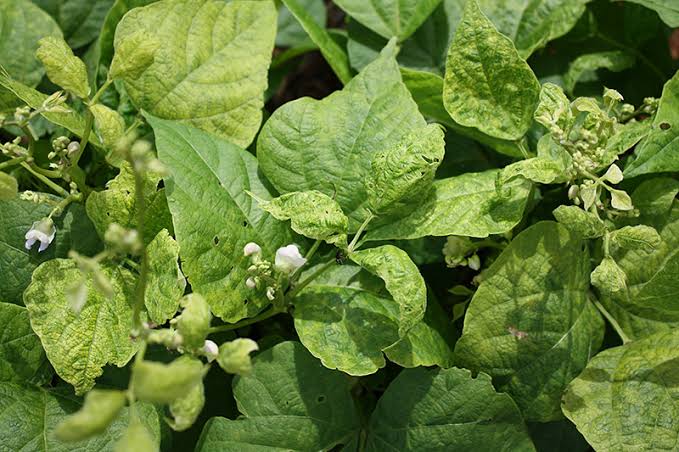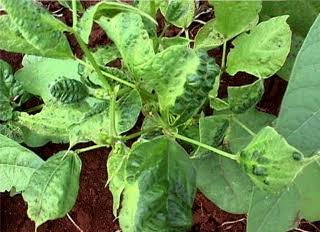Bean Common Mosaic Virus, scientifically known as Potyvirus, is a tiny but mighty adversary that affects legumes, especially our beloved beans. This viral interloper sneaks into the plant world, causing a mosaic-like pattern on leaves, hinting at the silent drama unfolding within.
As we delve into the microscopic realm, BCMV reveals its stealthy tactics. It is transmitted primarily by aphids, those minuscule insects that unwittingly play the role of viral couriers. These tiny intruders, equipped with a sophisticated suite of genetic material, hijack the plant’s cellular machinery, turning it into a viral replication factory.
The consequences are not merely aesthetic; the infected plants exhibit a range of symptoms. Mottled leaves, stunted growth, and reduced bean production are the telltale signs of BCMV’s subversive activities. It’s a tale of biochemical warfare at the cellular level, where the virus orchestrates a complex dance, manipulating the plant’s own systems for its replication.
The battleground extends beyond individual plants. As infected legumes succumb to BCMV, the virus cunningly spreads through seed transmission, perpetuating its legacy to the next generation. This relentless cycle poses a challenge to agriculture, affecting bean crops globally.
Scientists and agriculturalists engage in a perpetual struggle to understand BCMV’s intricate biology and develop strategies to mitigate its impact. Resistance breeding emerges as a beacon of hope, as researchers work tirelessly to cultivate bean varieties equipped with genetic armor against this viral invader.
In our quest for sustainable agriculture, the story of Bean Common Mosaic Virus stands as a testament to the delicate balance between nature’s resilience and the ingenuity of human intervention. As we navigate the intricate web of plant-virus interactions, our understanding deepens, paving the way for innovative solutions to safeguard our bean fields from this microscopic adversary.
Read Also: Appearance and Features of Yellow Perch Fish
Plants Affected by Bean Common Mosaic Virus (Potyvirus)

Bean Common Mosaic Virus (BCMV) doesn’t discriminate; it infiltrates a variety of leguminous plants, wreaking havoc on their well-being. Commonly afflicted species include beans (Phaseolus vulgaris), soybeans (Glycine max), and cowpeas (Vigna unguiculata). This viral interloper’s versatility extends beyond these staples, as it can also target ornamental legumes, such as sweet peas (Lathyrus odoratus).
As BCMV infiltrates these plants, its insidious effects manifest in diverse ways. The mosaic-like patterns on leaves, stunted growth, and reduced yield serve as universal indicators of infection across these susceptible species. The virus exploits the commonalities in their cellular makeup, navigating the plant kingdom with ease.
The impact on agricultural practices is profound, as BCMV’s reach extends globally. Whether in the vast bean fields of South America or the soybean plantations of North America, the virus poses a constant threat, demanding vigilant monitoring and strategic management to curb its spread.
As researchers continue to unravel the complexities of Bean Common Mosaic Virus, understanding its broad spectrum of hosts becomes crucial. This knowledge not only aids in developing resistant cultivars for specific species but also contributes to the broader goal of fortifying our agricultural systems against this pervasive viral menace.
Damages Caused by Bean Common Mosaic Virus

Bean Common Mosaic Virus (BCMV) leaves a trail of agricultural disruption, causing substantial damages to leguminous crops. The consequences of its insidious presence are manifold and impact both the quantity and quality of harvests.
1. Yield Reduction: BCMV is notorious for hampering the growth and development of infected plants. It stunts their overall growth, leading to a decrease in the number of pods and beans produced. This translates directly into reduced yields for crops like beans, soybeans, and cowpeas.
2. Mottled Leaves and Distorted Growth: One of the distinctive signatures of BCMV infection is the mosaic-like pattern that appears on leaves. This visual disruption isn’t merely cosmetic; it reflects the interference in the plant’s photosynthetic processes. As the virus takes control, the leaves may become mottled, yellowed, and distorted, compromising the plant’s ability to harness sunlight for energy.
3. Seed Transmission: BCMV is adept at perpetuating its lineage through seeds. Infected seeds carry the viral burden, passing it on to the next generation of plants. This seed transmission perpetuates the cycle of infection, making it challenging to break the viral chain and leading to recurrent outbreaks in subsequent crops.
4. Economic Impact: The economic repercussions of BCMV are significant. Reduced yields and poor-quality harvests affect farmers’ incomes, disrupting the delicate balance of agricultural economies. The costs associated with managing BCMV outbreaks, including the implementation of control measures and the development of resistant crop varieties, add an additional burden on agricultural resources.
5. Global Agricultural Threat: BCMV’s ability to affect a range of leguminous crops makes it a global concern. From the vast bean fields in Africa to the soybean plantations in Asia, this virus poses a constant threat to food security and agricultural sustainability.
As researchers strive to devise effective strategies for managing and preventing BCMV outbreaks, understanding the multifaceted damages it inflicts remains paramount. The battle against this viral adversary involves not only protecting individual crops but safeguarding the broader agricultural landscape from the pervasive impacts of Bean Common Mosaic Virus.
Read Also: The Appearance and Features of Trout Fish
Control and Preventive Measures

Controlling and preventing Bean Common Mosaic Virus (BCMV) requires a multi-faceted approach, combining cultural, biological, and chemical measures. These strategies aim to mitigate the impact of the virus on leguminous crops and limit its spread. Here are key control and preventive measures:
1. Resistant Varieties: Developing and cultivating bean varieties with inherent resistance to BCMV is a primary strategy. Through selective breeding, researchers work to identify and propagate plants with genetic traits that confer resistance, creating crops less susceptible to viral infection.
2. Crop Rotation: Implementing a well-planned crop rotation system disrupts the virus’s cycle. By avoiding planting legumes in the same location year after year, the chances of BCMV persisting in the soil and infecting subsequent crops are reduced. This simple yet effective cultural practice can help break the virus’s transmission chain.
3. Vector Control: Since BCMV is primarily transmitted by aphids, managing these insect vectors is crucial. Introducing natural predators of aphids, such as ladybugs or parasitic wasps, can help control aphid populations. Additionally, using insecticides selectively and responsibly can aid in minimizing aphid infestations.
4. Sanitation Practices: Practicing good sanitation in agricultural settings is vital. Removing and destroying infected plant residues, weeds, and volunteer plants can eliminate potential sources of BCMV. Thorough cleaning of equipment and tools helps prevent the inadvertent spread of the virus.
5. Seed Testing and Certification: Regular testing of seeds for BCMV is essential to ensure that the planting material is free from the virus. Certified disease-free seeds reduce the risk of introducing BCMV into new fields, contributing to a more resilient and disease-resistant crop.
6. Strict Quarantine Measures: Enforcing strict quarantine measures in regions where BCMV is prevalent helps prevent the introduction of infected plant material to disease-free areas. Monitoring and regulating the movement of seeds, plants, and agricultural equipment contribute to containment efforts.
7. Public Awareness and Education: Educating farmers about the symptoms of BCMV, its transmission, and preventive measures is crucial. Building awareness helps empower farmers to identify and respond promptly to potential outbreaks, reducing the overall impact of the virus on crops.
By integrating these control and preventive measures into agricultural practices, farmers and researchers strive to create a resilient and sustainable environment where leguminous crops can thrive without succumbing to the damaging effects of Bean Common Mosaic Virus.
Frequently Asked Questions (FAQs) About Bean Common Mosaic Virus (Potyvirus)
Q1: What is Bean Common Mosaic Virus (BCMV)?
A1: Bean Common Mosaic Virus is a plant virus that primarily affects leguminous crops, causing characteristic mosaic patterns on leaves and leading to reduced yields. Its scientific name is Potyvirus.
Q2: Which plants are susceptible to BCMV?
A2: BCMV infects a range of leguminous plants, including common beans (Phaseolus vulgaris), soybeans (Glycine max), cowpeas (Vigna unguiculata), and ornamental legumes like sweet peas (Lathyrus odoratus).
Q3: How is BCMV transmitted?
A3: BCMV is primarily transmitted by aphids, small insects that act as vectors carrying the virus from infected plants to healthy ones. Seed transmission is another common mode of spread.
Q4: What are the symptoms of BCMV infection?
A4: Infected plants often exhibit mosaic-like patterns on leaves, stunted growth, and reduced yields. Mottled and distorted leaves are common visual indicators of BCMV infection.
Q5: Can BCMV be controlled or prevented?
A5: Yes, several measures can help control and prevent BCMV. These include cultivating resistant plant varieties, practicing crop rotation, managing aphid vectors, ensuring seed quality, and implementing sanitation practices.
Q6: Is BCMV a global concern?
A6: Yes, BCMV poses a global threat to leguminous crops. Its ability to affect diverse plants and spread through seeds makes it a challenge for agricultural practices worldwide.
Q7: How can farmers identify BCMV in their crops?
A7: Farmers should watch for mosaic patterns on leaves, stunted growth, and reduced yields. Regular testing of seeds and plants for the virus can also aid in early detection.
Q8: Are there any chemical treatments for BCMV?
A8: While there is no specific chemical cure for BCMV, insecticides can be used to manage aphid vectors. However, integrated pest management and other preventive measures are often more sustainable approaches.
Q9: Can BCMV be transmitted through contaminated equipment?
A9: Yes, contaminated equipment and tools can contribute to the spread of BCMV. Practicing good sanitation by cleaning and disinfecting equipment helps prevent inadvertent transmission.
Q10: What role does public awareness play in managing BCMV?
A10: Public awareness is crucial in identifying and responding to BCMV outbreaks. Educating farmers about symptoms, prevention, and control measures empowers them to protect their crops effectively.
Read Also: Basic 7-minute Workout Routines and It’s Intricacies

